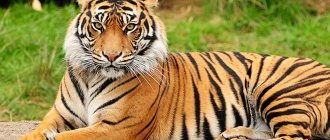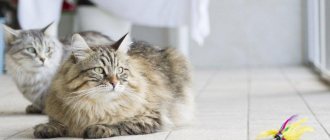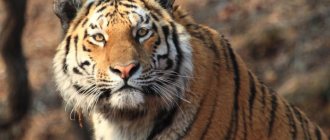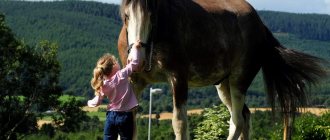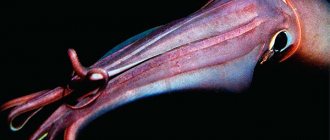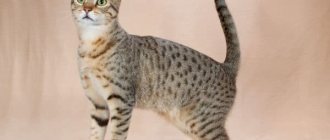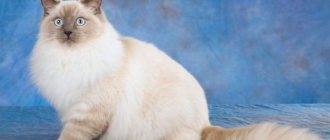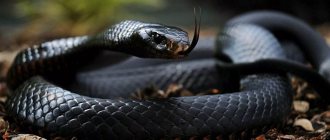How much does the biggest cat weigh?
It is known that the size of a predator depends on the size of its prey. Domestic cats, no matter what breed they belong to, hunt rodents, reptiles, and birds weighing up to 1 kg. The second important factor is the size of the ancestors. Domestic “tigers” have a Libyan wild cat (Felis silvestris lybica) weighing 4–7 kg. Therefore, the average weight of a pet rarely exceeds 3.5–4.5 kg.
An animal living in an apartment is more likely to gain excess weight than an animal living on the street due to the difference in physical activity. But the non-household pet will become longer or higher at the withers than its fellow tribesmen. To increase in size, you will need tall and massive ancestors. These are the breeds we will talk about.
The top 10 largest cats include:
- Siberian cat;
- ragamuffin;
- Turkish van;
- British Shorthair;
- chartreuse;
- Norwegian forest;
- ragdoll;
- khausi (chausi);
- savannah;
- Maine Coon.
Fat cats from the Internet
The appearance of furry fatties on the Internet never goes unnoticed. People are ready to look at them every day, so their photos and videos are always in the top. Some get thousands and sometimes millions of views in a matter of days and become real celebrities. Often, when looking at such photos, you immediately want to go on a diet yourself. Sometimes fat cats try to get lost among the interior or blend in with the environment.
On the Internet you can find photographs of fat bellies getting stuck in various holes - this is the time to think about an emergency diet!
But still, most of them, at any weight, feel like the most beautiful and graceful creatures who have come into our lives for us to constantly admire them, regardless of whether they are fat or not.
In addition to photographs, owners of fat cats constantly strive to capture their pets on video, so we can enjoy watching fluffy fat cats having fun, funny asking for food or playing around like little children.
- Combating Pet Obesity
- Obesity in cats and kittens
- Standards for feeding cats and kittens with dry and wet food
Siberian cat
The exceptionally beautiful Siberian cat is already 1000 years old. Russian felinologists (this is the name given to specialists who study the anatomy, physiology and habits of domestic cats) believe that the first “Siberians” were brought to Russia by merchants from Central Asia. Over time, harsh climatic conditions forced cats to acquire long hair. Just like the Chartreuse, the Siberian cat grows up to 5 years. An adult male weighs 4–6 kg. The height of the male is 40 cm, the female is 30 cm.
View this post on Instagram
A post shared by Victor Ray (@v1cr4v)
The Russian breed standard was recognized by the World Cat Federation in 1991. Since the 2000s, the Siberian cat has been considered the national breed of Russia.
Tulle
Nine-year-old Tulle has surpassed previous participants in the ranking of fat cats. The red-haired pet, which has gained 20 kg, lives in Denmark.
A cat, when it lies motionless, can be confused with a small fluffy pillow or ottoman. The owners cannot refuse the cute little cat his constant desire to eat something tasty. Over time, Tulle lost interest in outdoor games and indulged in laziness. It is difficult for the cat to walk, and in order not to get up, he has learned to roll like a ball, and in this way he gets to the bowl of food. Of all the activities, Tulle chooses sleep.
Currently, the hero is following a diet, because his weight is approaching a critical point.
British Shorthair
The theory of the origin of the British Shorthair states that the ancient Romans brought cats with them from Egypt, which, having crossed with local ones, laid the foundation for the British Shorthair. All this happened in the 1st century AD. e.
View this post on Instagram
A post shared by Victor Ray (@v1cr4v)
The most recognizable are the “British” ones with blue-gray fur. But there are others: cream, black, white, silver, tortoiseshell. Animal height – 30–45 cm. Weight – 5–9 kg.
Chartreuse
The ancestors of the Chartreuse are unknown. But felinologists associate the appearance of the breed with the Crusaders and the Order of the Carthusians. Chartreuses accompanied ships to Africa, saving ship supplies from rodents.
View this post on Instagram
A post shared by Victor Ray (@v1cr4v)
The cat has 2 features. First of all, there is a pronounced hunter’s instinct. Therefore, the animal is not recommended to live together with rodents and birds. Another feature is long-term growth. The pet grows up to 5 years. The height of an adult Chartreux is 30 cm, weight is 7–9 kg for a male and 4–5 kg for a female.
SpongeBob
In 2012, a huge orange cat ended up in a cat shelter because his owner was sent to a nursing home. SpongeBob stunned animal rights activists with his enormous size. It was difficult to measure it using a 15-kilogram scale.
The cause of abnormal obesity in a ginger cat is considered to be the inability of the elderly owner to provide proper care to the pet. He gave the animal plenty of food. Since no one limited SpongeBob's food intake, he ate as much as he wanted. Such constant overeating led the red-haired glutton to record weight.
Fat cat SpongeBob: YouTube/Top Fact
To combat the animal’s obesity, the shelter staff put the cat on a diet and developed a series of exercises:
His diet was based on lean chicken and vegetables. Diet and exercise gave results: the cat lost a couple of kilograms. He could even jump again and overcome small obstacles on his own. The shelter staff allowed SpongeBob to move around the entire territory of the shelter on his own, since any physical activity was good for the cat.
The cat managed to lose weight and was adopted by a married couple from New York. Unfortunately, the cat had serious health problems due to obesity.
Norwegian forest
The breed was obtained by natural crossing of domestic and wild forest cats (weight – 3–8 kg, body length – up to 80 cm). The furry Viking pet is the only breed that can climb down from a tree, moving head down.
View this post on Instagram
A post shared by Victor Ray (@v1cr4v)
It is believed that the seals in the ancient images of the chariot of the goddess Freya are the ancestors of the Norwegian forest cat. The height of the animal at the withers is 40 cm. Weight is 6–11 kg.
Prevention
Preventing obesity in cats is quite simple - there are a few simple rules to follow:
- Do not overfeed! And also monitor the quality of the feed. Don't skimp on it. Do not mix or alternate “drying” and “natural”. You can often determine by eye how much food is normal for a cat and how much is not. And even if your plump pet furry demands his portion - be adamant and feed on schedule. Week 2 and he capitulates.
- Don't limit your pet's play. Provide sufficient physical activity, because the cat is a predator by nature and must run to feed itself now. Do not deprive the mustache of this opportunity. They put food in his bowl at the first “meow,” so where does the energy go? Play more often, let the cat run, otherwise he will quickly become fat.
- Change your diet. If your mustache is castrated/sterilized, then be sure to review the diet and choose a special diet. And be sure to play with your furry four-legged friend more often.
Ragdoll
This is a breed obtained through selection in the 20th century. Breeder: Ann Baker from California, USA. The breed was registered in 2000. Known for her flexible character.
View this post on Instagram
A post shared by Victor Ray (@v1cr4v)
The name comes from the habit of relaxing. The pet purring in your arms sags, resembling a rag doll. It is believed that the observed flexibility of the cat is associated with a genetic disorder. Height at withers – 30–40 cm. Weight – 7–12 kg.
It is important about the health of the wards
Today, in many developed countries, special attention is paid to the protection of animals, as well as control of their keeping at home. For neglect, abuse and failure to fulfill obligations to care for animals, the guilty owners face heavy fines, and in some especially serious cases, even imprisonment.
One of the main aspects of a pet’s well-being and health is proper nutrition, a balanced diet and physical activity.
Therefore, it is very important not to overfeed, not to self-medicate, and to take medications, especially hormonal ones, only under the supervision of a veterinarian
Beginning in 1998 (some sources say 2003), representatives of the Guinness Book of Records officially stopped accepting applications for setting any animal records related to their diet, weight and food consumption. It is believed that this can cause significant damage to the health of the animal, since some owners deliberately overfeed them in order to get the coveted victory in the nomination.
All domestic cats found in urban areas and beyond have common roots. They are believed to be a subspecies of the forest cat, domesticated 10,000 years ago. According to statistics, there are 600 million domestic cats in the world today, and each of them belongs to 1 of 256 breeds.
Over a period of thousands of years, each breed has acquired individual traits and parameters that a person can easily navigate when choosing a pet. Cats differ not only in appearance, each has its own individual temperament and even a tendency to hereditary diseases that is passed on to the offspring. These characteristics make up the calling card of each breed.
Below is information about the largest cat breeds, the star cat Omar and the humane ban on one of the cat nominations in the Guinness Book of Records.
Housey (chausie)
The third place in the top is occupied by the hydrid of the jungle cat and the domestic cat – chausie. The length of the wild ancestor is 60–90 cm, weight is 8–12 kg. Special features: short tail and tufted ears. Chausie weight is 14–16 kg. Height at withers – 40 cm.
View this post on Instagram
A post shared by Victor Ray (@v1cr4v)
The breed owes its popularity to tourists visiting Egypt. Travelers noticed the soft sandy color, regal manners and hunting skills of the furry resident of this eastern country. The stories of tourists interested the breeders. As a result, in 1960 the first American-bred Chausies appeared.
Watson
A very fat cat was brought to one of the British shelters. He weighed more than 15 kg. The owners fed the cat uncontrollably and did not force him to move, which is why he gained excess weight.
Obesity prevented the animal from living a normal life; he could not use the litter box normally. According to shelter employees, the cat looked very sad and shy.
Sheila, the director of the shelter, began a program to rescue the chubby cat. First of all, she changed the cat’s old name, Fatty, to a new one: Watson. The cat was put on a strict diet: he received no more than 70 g of low-calorie food at a time.
Sheila chose a very correct tactic for treating gluttony. The cat was not forced to move until the strict diet bore fruit. A year later, Watson began to show interest in the area around him. He often played, although lying down.
The cat was diagnosed with benign tumors and underwent surgery. Timely weight loss allowed the use of anesthesia. After the operation, Watson became an even more active cat:
At first he could jump on the sofa, and later on the windowsill, which he was extremely proud of.
The cat managed to reach a normal weight of 7 kg, which allows him to lead a normal cat life. Thanks to Sheila's competent approach to the cat's diet and gradual physical activity, Watson was able to lose weight without risk to the cardiovascular system.
The fattest cats in the world are an example of the irresponsibility of people. Improper care, excessive feeding and reluctance to take care of the pet lead to obesity in animals.
This condition causes serious problems and diseases in four-legged animals. Once in the hands of animal rights activists, fat cats receive the right treatment and diet that helps them return to normal life.
A unique selection of news from our editor-in-chief
Source
Savannah
The breed was obtained by crossing a Bengal cat with an African Serval. The serval weighs 8–18 kg, reaches 65 cm at the withers. The length of the body with tail is 90–135 cm. Savannah was registered in 2001. The height of the miniature relative of the cheetah at the withers reaches 60 cm. Weight is 15–18 kg.
View this post on Instagram
A post shared by Victor Ray (@v1cr4v)
In 2007, a new breed of Asher was introduced to the public. Upon careful analysis, it turned out that the cat belonged to the Savannah breed. Although some sources still believe that the Asher is a separate breed.
Maine Coon
The largest cat in the world is the Maine Coon. Native New Englander originally from Maine. A famous mousecatcher and ship's cat until the very beginning of the 20th century. Little is known about the origin of the giants. Some Felinogoli believe that the cat came to North America along with the Vikings in the pre-Columbian era. Others say that the cats of the French Queen Marie Antoinette were brought to America to save the fluffies from an angry people.
Considering the long biography of a member of the ship's crew, this cat should have genes from many breeds. There is even an assumption that the Maine Coon is a hybrid of a long-haired cat and a raccoon, which is impossible from a biological point of view.
View this post on Instagram
A post shared by Victor Ray (@v1cr4v)
The Maine Coon, the largest cat in the world, looks like this: a massive animal with smooth shaggy fur and a proportional body. Broad chested, muscular. Strong paws of medium length are covered with dense hair. A square muzzle with long tufted ears and stern eyes.
The brownish-striped color is so common that not everyone knows about other options: white, black, blue, silver, red. The largest purr weighs on average 8–12 kg. The height of the male at the withers is 33 cm. The largest seals live to the age of 13–17 years.
A kitten of any breed is expensive if it comes from record-breaking parents. In the case of Maine Coons, it is also taken into account that a large pet requires 4 times more food than a domestic purr weighing 5 kg. Therefore, the average price of the largest cat in the world is 100–150 thousand rubles. If the kitten’s parents are world exhibition record holders, then the cost reaches 700–1500 euros. But the average feed consumption per muzzle will cost the owners 15–20 thousand rubles per month.
How to determine obesity in cats?
Before you panic that your cat has become fat, you need to decide what you mean by normal. There is no accurate, clinically proven method for determining obesity in relation to cats and dogs. In the most common study, overweight is defined as over 15% of optimal body weight, and obesity as over 30% of the same figure. However, what is optimal body weight?
The article that we studied provides such a mathematical and morphological method for determining excess body weight in cats. Using a centimeter, we measure the diameter of the chest (LLC) at the level of the ninth rib and the limb length index (LLI) - the distance between the kneecap and the heel bone of the hind limbs. During measurements, the animal must stand straight and with its head raised. Having recorded the data in centimeters, we make calculations using the following formula:
Fat mass (%) = (DHA:0.7067 – IDK:0.9156) – IDK.
It’s more difficult with dogs, since in many breeds the morphology is greatly changed by humans, so they have developed their own way of calculating excess body weight.
The biggest cat in history
For decades, Himmy from Australia was considered the largest cat in the world. In 1986, at the time of his death, Himmi weighed 21.3 kg.
Guinness World Records soon eliminated the weight category, focusing on length and height. The record holder for length was a Maine Coon from Italy - Barivel. On May 22, 2022, the length of the record holder was 120 cm. However, Maine Coons grow up to 4 years old. In 2022, Barivel will turn 5 years old, which means the record holder has had time to grow up. Himmi was inferior in length to Barivelu and reached only 96 cm.
View this post on Instagram
A post shared by Victor Ray (@v1cr4v)
In the photo: Barivel is a record-breaking cat for size.
Patrick Deuel (486)
The maximum weight of another US resident, Patrick Diuel, was 486 kg. The man worked as a restaurant manager and was used to eating a lot in stressful situations and depression. This led to rapid weight gain. After leaving his job, Patrick sat at home and did not go outside for seven years, gradually gaining weight. By the end of this period, the man could not move or walk. To hospitalize Patrick, rescue services had to make a special opening in the wall, since the man could not fit through the door. They took him to the Sioux Falls clinic because it was the only one with doors large enough to take Patrick inside. Doctors performed surgery on the man to remove part of his stomach and pump out fat. Diuel spent about a year in treatment, during which he lost approximately 260 kg. After leaving the clinic, Patrick continued to lose weight, bringing his weight to 190 kg. He died in 2016.
Large wild cats
Wild cats are found all over the planet. Each species is unique in its own way.
Largest wild cats:
- cougars;
- leopards;
- jaguars;
- lions;
- tigers.
The puma is known by the names: mountain lion, cougar. Found from Alaska to Canada in North America to Chile in South America. Puma length is up to 2.4 m. Weight is 59–68 kg.
The leopard is a strong and inconspicuous spotted cat that lives in Asia and Africa. It grows up to 1.9 m in length and reaches a weight of 75 kg. Leopards are sometimes attacked by other large cats, including lions and tigers. To avoid problems, leopards hunt at different times than lions.
Jaguars are America's largest cats. Most jaguars live in the Amazon rainforest. Predators grow up to 2.7 m. They weigh up to 158 kg.
Lions are the second largest dangerous feline species in the world. And this is the most social cat living in a group (pride). The length of the male including the tail is 3 m. Weight is 250 kg.
The tiger was considered the largest cat in the world. The animal grows up to 3 m, like a lion, but the tiger is heavier and weighs 300 kg. About the same as three cougars combined.
The liger is the largest representative of the felines. This is a hybrid of a male lion and a tigress. The predatory liger grows larger than its parents. Weight - 400 kg and length - 4 m. The animal has a lion's yellow-fawn color with dark brown tiger stripes. There are white ligers. There are only black ones, since there are no black parent animals.
View this post on Instagram
A post shared by Victor Ray (@v1cr4v)
Hercules - the largest liger in the world
The first ligers appeared in the 19th century in India. In 2022, the largest liger included in the Guinness Book of Records was Hercules, weighing 418.2 kg. A hybrid of a tiger and a lioness is called a tigon. But this cat is smaller. The average lifespan of hybrids is 10–15 years.
Barsik
In 2022, the New York Post and animal rights activists conducted an active campaign to find adoptive parents for the American glutton Barsik. His weight was 41 pounds (about 19 kg). He ended up in a shelter because his previous owners were leaving New York and could not take the fat cat with them.
The Manhattan Animal Care Center did not have a cage that was the right size for Barsik. It was difficult to find scales to weigh him - they used dog scales.
According to animal rights activists, Barsik was obese and needed a family to help him reach his ideal weight. He was too big, so he lived right in the organization’s office.
Barsik practically could not move on his own; a special stroller was made for him. After examination and starting a strict diet, the cat began to slowly but surely lose excess weight.
Now the fat cat lives with a happy owner and has noticeably lost weight. Thanks to diet and exercise, his current weight is just over 20 pounds (less than 10 kg). Thanks to the loss of almost half of his weight, Barsik can move independently. However, he still loves to eat.
One of Barsik’s favorite treats is Italian pizza. Barsik currently holds the world record among cats for the amount of weight lost (result: minus 10 kg).
Meow is a fat cat who attracted public attention to the problem of excess weight in pets. His almost ninety-year-old owner could no longer take care of Meow.
When he was admitted to the shelter in 2012, the cat weighed 18 kg, and was clearly overweight. If we draw an analogy with a person, then with the same degree of obesity people weigh under three centners. Unofficially, Meow can be considered the heaviest cat in the world in 2012, although such records have no longer been recorded.
Fat cat Meow: Wikipedia
When weighed, the cat barely fit on the scales. Animal rights activists sounded the alarm, and the furry glutton was put on a strict diet. Meow's diet was based on a protein diet, which produced results in a short time. In a couple of months he lost 1 kg of weight and continued to lose weight.
The shelter planned to reduce the cat's weight by another 3 kg so that it could be given to a family. The problem of Meow obesity has been widely covered in the media and social networks:
The cat was very kind and flexible. Most of all he loved to be petted. With such weight, Meow could move independently and even climb the stairs.
But he was not interested in active games; he ignored all toys. Most likely, this was due to the fact that the cat was unable to chase rubber balls and mice.
Even though Meow could walk on his own, he was not flexible enough due to his fat. This prevented him from carrying out hygiene procedures on his own. In addition, for the rest of his life, Meow suffered from serious problems with the respiratory system.
